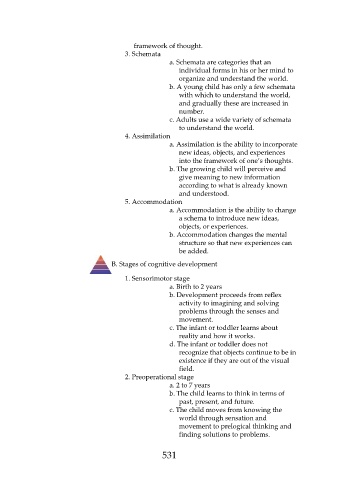Page 531 - Saunders Comprehensive Review For NCLEX-RN
P. 531
framework of thought.
3. Schemata
a. Schemata are categories that an
individual forms in his or her mind to
organize and understand the world.
b. A young child has only a few schemata
with which to understand the world,
and gradually these are increased in
number.
c. Adults use a wide variety of schemata
to understand the world.
4. Assimilation
a. Assimilation is the ability to incorporate
new ideas, objects, and experiences
into the framework of one’s thoughts.
b. The growing child will perceive and
give meaning to new information
according to what is already known
and understood.
5. Accommodation
a. Accommodation is the ability to change
a schema to introduce new ideas,
objects, or experiences.
b. Accommodation changes the mental
structure so that new experiences can
be added.
B. Stages of cognitive development
1. Sensorimotor stage
a. Birth to 2 years
b. Development proceeds from reflex
activity to imagining and solving
problems through the senses and
movement.
c. The infant or toddler learns about
reality and how it works.
d. The infant or toddler does not
recognize that objects continue to be in
existence if they are out of the visual
field.
2. Preoperational stage
a. 2 to 7 years
b. The child learns to think in terms of
past, present, and future.
c. The child moves from knowing the
world through sensation and
movement to prelogical thinking and
finding solutions to problems.
531

